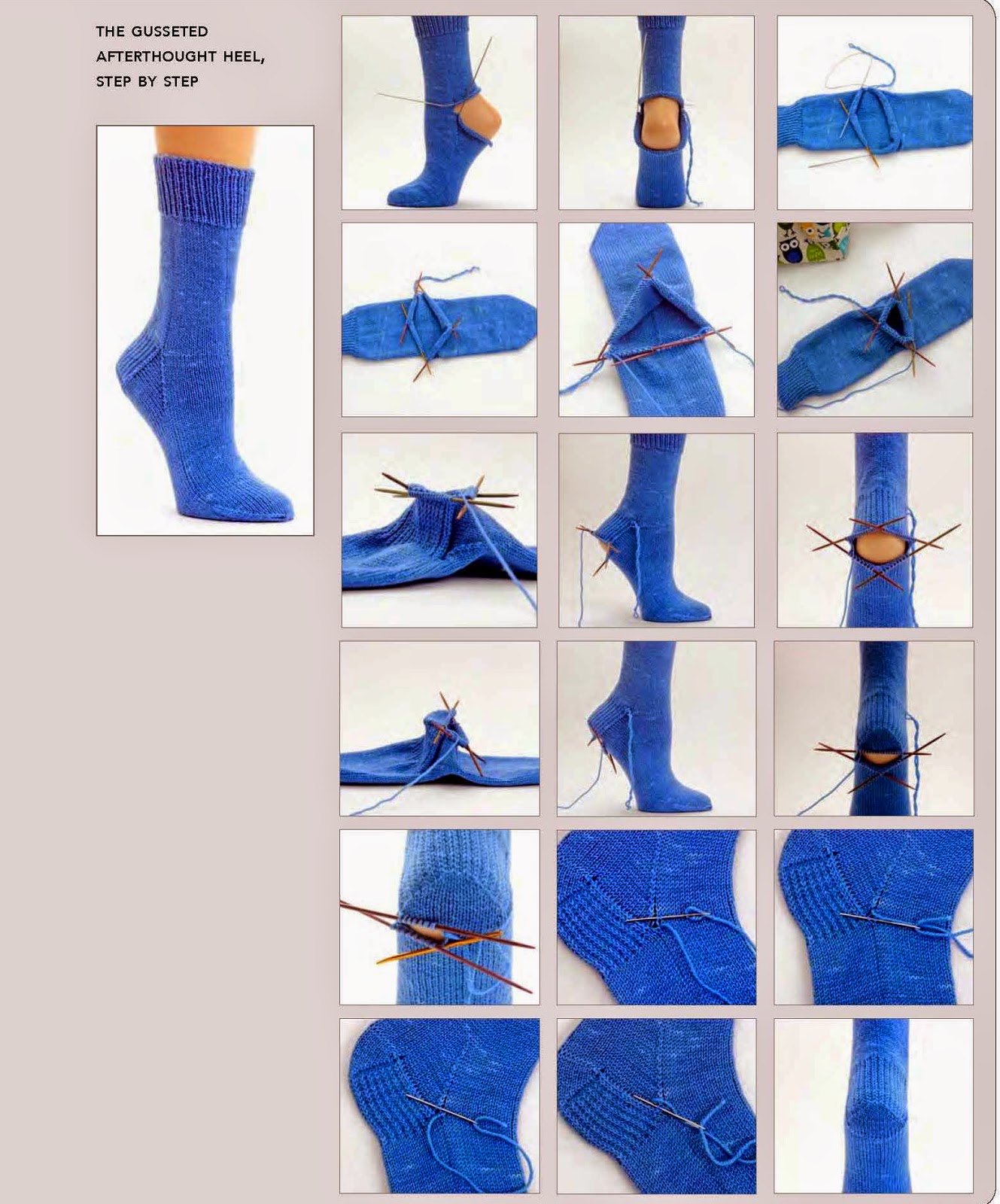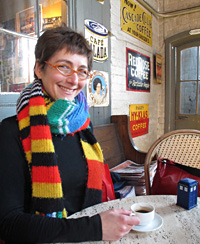I can't, for the life of me, find your contact info. Please get in touch? kate at wise hilda knits dot com.
Thank you!
Tuesday, September 30, 2014
Monday, September 29, 2014
Wednesday, September 24, 2014
Excellent new sock book: Lara Neel's Sock Architecture
Last year, I was asked to do a technical consult with Lara Neel on her sock book manuscript. I was off on a trip to tape my Craftsy class, so I printed out the draft, found my favourite manuscript-reviewing pen, and packed it into my carry-on luggage.
Now, without bragging, I do think I know a bit about sock knitting. I've been knitting socks for twenty years; I've read a lot of sock knitting books, and I've edited a fair number of sock patterns and books. And it was clear, by the time I got to the third page, that Lara knew a lot more about it than I did!
The book is a fantastic exploration of heel and toe constructions, both top down and toe up. She dives deep into the construction details and the fit for each, providing not only examples of how to use them, but also the math that allows you to adapt them for your own designs.
If you're not feeling mathematically inclined, Lara's designed a range of patterns that use these constructions. There's socks plain and fancy, for all sorts of fits and sock-knitting tastes. Many of the designs have two versions: one toe-up, one top-down. You might just find a new favourite go-to sock pattern....
Along the way, Lara shares an awful lot of wisdom and tips on sock knitting, construction and fit. I love the way she thinks: she understands that sock fit is about more than foot length, or indeed foot circumference, and she approaches each construction as a template that you can apply to your socks, and your own feet.
And the illustrations are generous, detailed, and very helpful. This step-by-step breakdown of the Afterthought Gusset heel construction is worth the price of the book, in my opinion...
Lara is kindly giving away a copy of the book to my readers... to win, leave a comment on this post before Saturday September 27th midnight EST, making sure I know how to get in touch with you. Leave your Ravelry name, or an email address, or some other way to find you.
And if you can't wait, buy the book here.
Now, without bragging, I do think I know a bit about sock knitting. I've been knitting socks for twenty years; I've read a lot of sock knitting books, and I've edited a fair number of sock patterns and books. And it was clear, by the time I got to the third page, that Lara knew a lot more about it than I did!
The book is a fantastic exploration of heel and toe constructions, both top down and toe up. She dives deep into the construction details and the fit for each, providing not only examples of how to use them, but also the math that allows you to adapt them for your own designs.
If you're not feeling mathematically inclined, Lara's designed a range of patterns that use these constructions. There's socks plain and fancy, for all sorts of fits and sock-knitting tastes. Many of the designs have two versions: one toe-up, one top-down. You might just find a new favourite go-to sock pattern....
Along the way, Lara shares an awful lot of wisdom and tips on sock knitting, construction and fit. I love the way she thinks: she understands that sock fit is about more than foot length, or indeed foot circumference, and she approaches each construction as a template that you can apply to your socks, and your own feet.
And the illustrations are generous, detailed, and very helpful. This step-by-step breakdown of the Afterthought Gusset heel construction is worth the price of the book, in my opinion...
Lara is kindly giving away a copy of the book to my readers... to win, leave a comment on this post before Saturday September 27th midnight EST, making sure I know how to get in touch with you. Leave your Ravelry name, or an email address, or some other way to find you.
And if you can't wait, buy the book here.
Monday, September 22, 2014
Vogue Knitting Live NYC, January 16-18 2015.
My favourite city in the world, doing my favourite thing in the world, in the month of my birthday. Perfect.
I'm teaching a range of socky classes...
- DPNs, Magic Loop and 2 Circs: Working in the Round bootcamp
- Going My Way: Work Socks the Way You want
- Heels and Toes
- Introduction to Sock Pattern Design
- Toe Up Socks 101
- Socks for Absolute Beginners
Thursday, September 18, 2014
Wednesday, September 17, 2014
Free Pattern: The Sick Day Shawl
It's that time of year: colds and flu bugs are starting to go around. The air is full of sneezing and sniffling and coughing.
I caught an early cold last week, and spent a day as the doctor ordered: on the sofa, with several pots of tea and a big box of Kleenex. I planned to luxuriate in some relaxing knitting and TV.
The TV decision was easy: I'm partway through watching MI-5 (a.k.a. Spooks) on Netflix. This is a 10-season English program feature attractive spies and ridiculous international adventures. Perfect.
The bigger question was what knitting? I've been working on a bunch of design projects of late, and I knew I wasn't in the mood to for anything complicated. But equally, with a full day stretching out ahead of me, I also knew I'd have time to really dig into a project. Plain socks seemed too dull.
Ever since I completed Rosetta Tharpe, I've been noodling on the idea of a Half-Pi shawl - a semi-circular shawl using the same basic construction. I'd got the math partially worked out, and so before the decongestant properly kicked in, I did a bit of number crunching and planning. And then I went diving in the stash.
(Because going yarn shopping while contagious with a cold seems impolite.)
I found a couple of skeins of Briggs and Little Regal. This is a great Canadian yarn, a classic heavy worsted, with a decent yardage (250yds per skein) and a nice crisp, wooly hand.
And so the Sick Day Shawl was born. By the end of the first day, I had a full skein knitted up. (Seriously, I did nothing else that day. We had leftovers for dinner, and I didn't have any urgent work obligations.)
Even with just that single skein, I got a good sized shawl...
Over the next couple of days, I spent a bit more time, and dug into the second skein.
And by Friday night, I had converted about 450yds of an abandoned heavy worsted from the bottom of my stash into the Sick Day Shawl.
Ideal for that day at home in front of the TV. Ideal for knitting when you're not up for much of a challenge, but not totally discombobulated with medication. No special yarn requirements: use whatever you've got in the stash. 450yds of anything in the worsted-y aran-y sort of category (a 4 or a 5, if you go that way). Two skeins of Cascade 220. (Who doesn't have 2 skeins of Cascade 220 kicking around?) A skein of Cascade Eco would be great. Double-strand some sock yarn! Do you have a bunch of handspun that needs using up? Use whatever needles you have on hand.
The design is entirely forgiving of messed-up stitch counts. Got the wrong number? Fix it on the following row. And it's flexible, too, for how far you go. Got more time and yarn? Just keep working to make it bigger. Feeling better? Stop sooner.
It's good for you, too: the knitting is interesting enough that you'll stay put on the sofa, resting as you're supposed to.
And next time you're feeling under the weather, you've got something warm and comfy to snuggle with.
Free pattern on Ravelry here. Thanks to Gillian Martin for the outstanding photos.
Pattern will be free until the end of September, but after that I'll be charging for it - I've got to replenish my Kleenex supplies.
I caught an early cold last week, and spent a day as the doctor ordered: on the sofa, with several pots of tea and a big box of Kleenex. I planned to luxuriate in some relaxing knitting and TV.
The TV decision was easy: I'm partway through watching MI-5 (a.k.a. Spooks) on Netflix. This is a 10-season English program feature attractive spies and ridiculous international adventures. Perfect.
The bigger question was what knitting? I've been working on a bunch of design projects of late, and I knew I wasn't in the mood to for anything complicated. But equally, with a full day stretching out ahead of me, I also knew I'd have time to really dig into a project. Plain socks seemed too dull.
Ever since I completed Rosetta Tharpe, I've been noodling on the idea of a Half-Pi shawl - a semi-circular shawl using the same basic construction. I'd got the math partially worked out, and so before the decongestant properly kicked in, I did a bit of number crunching and planning. And then I went diving in the stash.
(Because going yarn shopping while contagious with a cold seems impolite.)
I found a couple of skeins of Briggs and Little Regal. This is a great Canadian yarn, a classic heavy worsted, with a decent yardage (250yds per skein) and a nice crisp, wooly hand.
And so the Sick Day Shawl was born. By the end of the first day, I had a full skein knitted up. (Seriously, I did nothing else that day. We had leftovers for dinner, and I didn't have any urgent work obligations.)
Even with just that single skein, I got a good sized shawl...
And by Friday night, I had converted about 450yds of an abandoned heavy worsted from the bottom of my stash into the Sick Day Shawl.
Ideal for that day at home in front of the TV. Ideal for knitting when you're not up for much of a challenge, but not totally discombobulated with medication. No special yarn requirements: use whatever you've got in the stash. 450yds of anything in the worsted-y aran-y sort of category (a 4 or a 5, if you go that way). Two skeins of Cascade 220. (Who doesn't have 2 skeins of Cascade 220 kicking around?) A skein of Cascade Eco would be great. Double-strand some sock yarn! Do you have a bunch of handspun that needs using up? Use whatever needles you have on hand.
The design is entirely forgiving of messed-up stitch counts. Got the wrong number? Fix it on the following row. And it's flexible, too, for how far you go. Got more time and yarn? Just keep working to make it bigger. Feeling better? Stop sooner.
It's good for you, too: the knitting is interesting enough that you'll stay put on the sofa, resting as you're supposed to.
And next time you're feeling under the weather, you've got something warm and comfy to snuggle with.
Free pattern on Ravelry here. Thanks to Gillian Martin for the outstanding photos.
Pattern will be free until the end of September, but after that I'll be charging for it - I've got to replenish my Kleenex supplies.
Saturday, September 06, 2014
The Teaching Season Begins
I'm a year-round knitter, but it's true that the majority of events and teaching take place in the fall and winter.
And boy, I'm going to be busy. Can't wait.
Maybe I'm going to be teaching at an event near you? Take a look at my schedule - just to your left!
And remember, if you can't come and take one of my classes in person, I have online classes, too:
Learn to Knit
Magic Socks
Blocking
Fixing Mistakes
Gapless Gussets
Sizing and Fit
Look a little further down on the left for links.
And boy, I'm going to be busy. Can't wait.
Maybe I'm going to be teaching at an event near you? Take a look at my schedule - just to your left!
And remember, if you can't come and take one of my classes in person, I have online classes, too:
Learn to Knit
Magic Socks
Blocking
Fixing Mistakes
Gapless Gussets
Sizing and Fit
Look a little further down on the left for links.
Tuesday, September 02, 2014
On Holding of Hands and Not
Question: Do you think by walking knitters step by step and hand holding in patterns is generating a generation of very dependent knitters?
— Rohn Strong (@strongandstone) September 2, 2014
This question on Twitter raised my blood pressure a bit today. Mostly in the good way... ;-).This "debate" comes up reasonably often. The crux of it is this: Older patterns used to be more terse (concise?), and newer ones give more detail. Are we enabling knitters to be lazy/not encouraging thinking for themselves/hampering learning/etc. by giving that extra detail?
For example, you might see in an older pattern an instruction like:
Decrease 1 st each end of every foll alt row 10 times, then every 4th row 12 times.There's nothing wrong with the first formulation, but it requires a fair bit of knowledge on the pattern of the knitter. What decrease to use, where to place them, and to be comfortable keeping track of the various rows, including knowing what we mean by "foll alt row".
A more "modern" pattern would be more likely to spell it out, e.g.
Next row, decrease (RS): K1, ssk, k to last 3 sts, k2tog, k1. 2 sts decreased.Both are equally correct, but they are very different.
Follow row (WS): Purl.
Repeat the last 2 rows 9 more times.
Work a decrease row followed by three even rows.
Repeat the last four rows 11 more times.
I tend to tell designers that if they aren't certain a knitter will do it the way they want, or if it matters what decrease is used and where it's placed, then it's better to spell it out.
In my experience, it's mostly designers asking the question. I can see where they are coming from: it's much easier to write a pattern in that concise/terse way, absolutely. And as a designer, you've likely got the skill level to be comfortable with the concise version so you might not understand the need for the more explicit version.
But we're not all designers. We're not all experienced knitters. And we don't all innately know how to read and follow patterns. The traditional, concise pattern format isn't very friendly to newer knitters. Why not give knitters a bit of a helping hand?
I liked this answer to the question:
@strongandstone I want knitting patterns to provide as much information as possible so that I don't have to question the designer.
— Angela Hockabout (@KnitLuck) September 2, 2014
My answer to Rohn was in two tweets, since I had so much to say:
@strongandstone Controversial question: the right answer IMHO is to write in a manner appropriate to knitter exp/skill. 1/2
— Kate Atherley (@wisehilda) September 2, 2014
@strongandstone More detail for newer knitters; less for more exp. knitters. You can't get experienced w/o hand being held a bit. 2/2.
— Kate Atherley (@wisehilda) September 2, 2014
I've discussed this with Donna Druchunas on a couple of occasions, and she's very much a fan of the more concise style. Her position is that hand-holding can get ridiculous... that it shouldn't get to the point where every pattern is its own tutorial, and every pattern has to explain everything right from casting on. I agree with her on that point! But I do feel that there's room to help - to provide a helping hand for those who are just getting started, or who want it.My answer is that we should be using some sort of skill level/techniques required/experience level required indicator in the pattern, and use that as a guide to how we write our patterns. If you want to write in the concise way, just tell people up front that you're expecting pattern reading experience! And if you to target your pattern to less experienced knitters, write in a more explicit manner, and then market it as such. Knitters will thank you.
After all, we all need a helping hand at first - let's offer that help to those who want it.
UPDATE: Angela (of the tweet above) has written a terrific blog post on this topic, from the end-user's perspective. Read it.
Sidebar:
I wonder if this question wasn't prompted by this tweet of mine, from a little earlier...
Knit designers: if yr reply to question abt something in a patt is "I assume most knitters would probably ... ", consider adding more info.
— Kate Atherley (@wisehilda) September 2, 2014
This was in response to a great conversation I was having with a designer about how to represent some instructions in her patterns... I asked a question about why she chose to give gauge information over 1 inch, rather than four. Her reply was, in essence, "well, I assume most knitters know you have to check it over more than just one inch".For her patterns, which are mostly aimed at more experienced knitters, this is probably ok. But my reply to her was simple: consider the experience level of your target knitter. (Although there's a separate discussion here to be had about going with commonly-used form. My biggest issue with specifying gauge over anything other than 4 inches, which is what most patterns and yarns do, is that it can be misread or confuse. If there's a commonly-used form, I like to use it. Makes it easier on everyone, IMHO.)
Subscribe to:
Posts (Atom)














